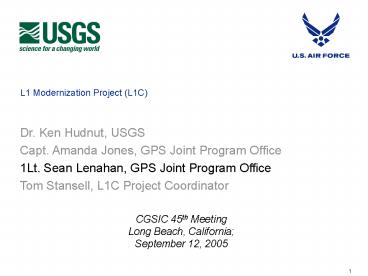L1 Modernization Project L1C - PowerPoint PPT Presentation
1 / 20
Title:
L1 Modernization Project L1C
Description:
Capt. Amanda Jones, GPS Joint Program Office. 1Lt. Sean Lenahan, GPS Joint Program Office ... Capt. Amanda Jones. Co-Chair, GPS JPO. Dr. Ken Hudnut. Co-Chair, USGS. 7 ... – PowerPoint PPT presentation
Number of Views:60
Avg rating:3.0/5.0
Title: L1 Modernization Project L1C
1
L1 Modernization Project (L1C)
Dr. Ken Hudnut, USGS Capt. Amanda Jones, GPS
Joint Program Office 1Lt. Sean Lenahan, GPS Joint
Program Office Tom Stansell, L1C Project
Coordinator
CGSIC 45th MeetingLong Beach, California
September 12, 2005
2
Background (1 of 3)
- The Interagency GPS Executive Board (IGEB) funded
an L1C Signal Definition Project - Co-chaired by the U.S. Geological Survey (USGS)
and the GPS Joint Program Office (JPO) - First phase of the project was completed in 2004
- Report posted on two WEB sites www.pnt.gov and
www.navcen.uscg.gov/gps/modernization/ - Thanks to those who participated in the first L1C
survey - Your contributions were very important and moved
us closer to the final L1C definition
3
(No Transcript)
4
Background (2 of 3)
- Last year at this meeting Dr. Hudnut reviewed
conclusions of the Phase I report - You may recall the debate which ensued
- The specific issue was not a problem after all
- The first survey results recommended
- Implementing L1C in addition to the C/A signal
- The BOC(1,1) waveform
- A more robust data channel
- We also were guided toward more use of alternate
communication means
5
Background (3 of 3)
- A second phase of the L1C Project was approved in
2005 - Intended to complete the definition of L1C
- The IGEB has been replaced by the National
Space-Based Positioning, Navigation, and Timing
Executive Committee (the EXCOM) - Final L1C report will be submitted to the EXCOM
- New JPO participants
6
L1C Team Leadership
Capt. Amanda JonesCo-Chair, GPS JPO
Dr. Ken HudnutCo-Chair, USGS
Tom StansellCoordinator
1Lt. Sean LenahanGPS JPO
7
And An Experienced Technical Team
- The following members of the L1C Technical Team
have made important contributions to the signal
definition and this presentation
- Lt. Col. Jon Anderson, USAF
- Dr. John Betz, MITRE
- Dr. Charles Cahn, Consultant
- Dr. Phil Dafesh, Aerospace
- Dr. Chris Hegarty, MITRE
- Mr. Rich Keegan, Consultant
- Mr. Karl Kovach, ARINC
- Dr. Howard Ma, MITRE
- Dr. Joe Rushanan, MITRE
- Mr. Soon Yi, ARINC
8
Introduction to New L1C Questionnaire
- We request your advice on the L1C design by
choosing from five signal options - We want to know why and to what extent you favor
one option over the others - This presentation provides the information needed
to make informed choices
9
Looking Into the Future
- GPS Galileo provides better geometry
- UWB and other sources raise the noise floor
- Moores law continues to apply
- gt 10 times digital improvement before L1C launch
- Improved technology will allow better performance
- Proliferation of GPS communication sources
- Cell phones, wireless internet, SBAS, GBAS, etc.
- Alternate GPS message sources will provide
- Long-lasting clock and ephemeris for all
satellites - Integrity and differential correction messages
- User alerts, e.g., software updates, system
status, etc.
10
L1C Shares L2C L5 Improvements
- L1C builds on improved characteristics of other
modernized GPS signals - Signal power split between data data-less parts
- Data-less part is a pilot carrier
- Better tracking threshold
- Eliminates ½ cycle phase ambiguities
- Forward error correction (FEC) improves (lowers)
message demodulation threshold - Longer spreading codes
- Reduce susceptibility to narrowband and
cross-satellite interference - Resolve data timing ambiguity (no bit sync
required)
11
Additional L1C Improvements (1 of 2)
- After the 1st L1C report, we found a way
- To increase the data rate for faster time to
first fix - While being able to demodulate the vital message
data at the lowest tracking threshold - This message structure is (herein) called CNAV-2
- L2C and L5 messages are called CNAV
- Other L1C message improvements
- More powerful FEC further improves demodulation
- Interleaving minimizes effect of short fades
- e.g., driving past trees or other obstructions
12
L1C Improvements Defined (1 of 2)
13
L1C Improvements Defined (2 of 2)
14
Carrier and Data Power Allocations
FastestTTFF Variable Messages
Best Code Carrier TrackThreshold
Most Robust VariableMessages
With 50 or 75 bps?
15
Questionnaire Choices
Choose Preferred Options and Explain Why
16
Page 1 of the Questionnaire
17
Page 2 of the Questionnaire
18
Participants in an initial briefing in Tokyo on
8 Sept. 2005
19
Please Participate
- Please participate in the new L1C Survey
- Sign up on the list, or
- Give us your card marked with a request
- Surveys can be conducted almost anywhere (even
simultaneously at multiple locations) using
telephone and an Internet connection - Windows only
20
End of Presentation
The L1C Project was initiated and funded by the
Interagency GPS Executive Board (IGEB) with
substantial support also provided by the U.S. Air
Force GPS Joint Program Office (JPO) and the
Federal Aviation Administration (FAA)

